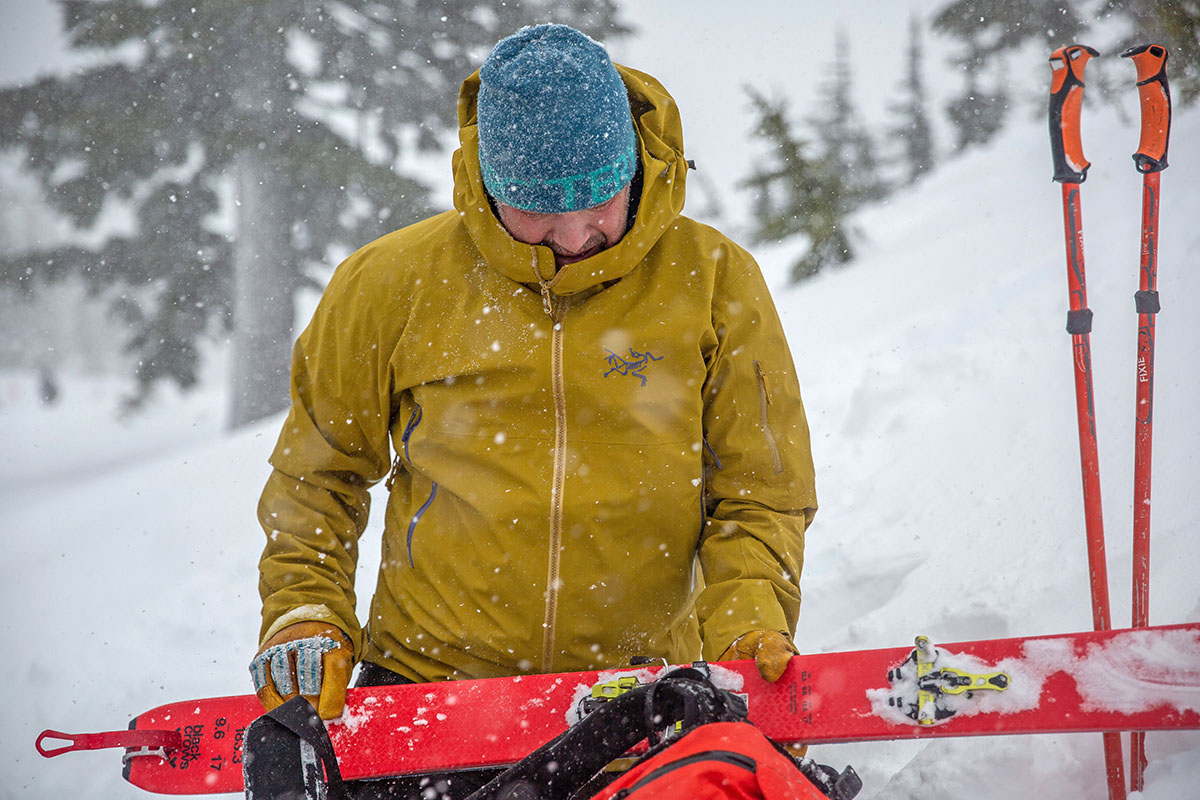
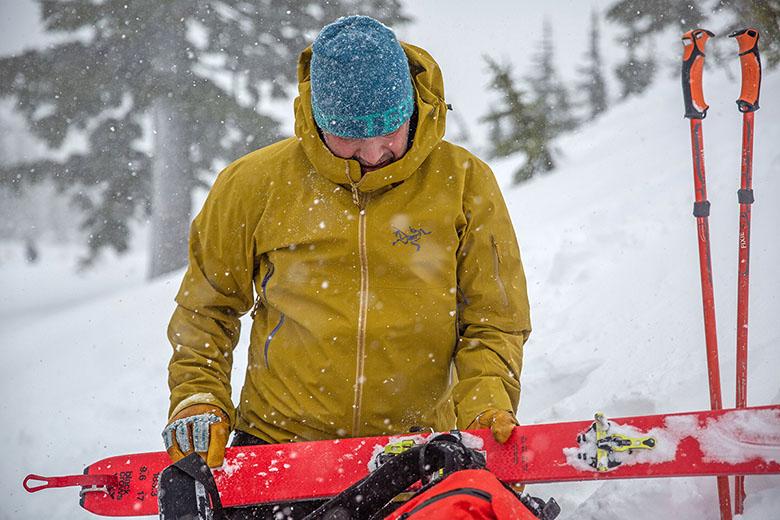
Price: $750
Weight: 1 lb. 8.9 oz.
Waterproofing: 3L Gore-Tex ePE
What we like: Fantastic protection, comfort, and mobility in a great-looking package.
What we don’t: Fairly heavy and bulky for backcountry use; no small investment at $750.
Arc’teryx offers an extensive lineup of quality ski jackets, from technical hardshells to insulated resort options. The Sabre Jacket (formerly the Sabre AR) slots in right in the middle, with a premium Gore-Tex build, light flannel backer, and smartly designed feature set. We put the versatile shell through a full season of skiing in the Pacific Northwest and consider it the benchmark do-it-all ski and snowboard jacket. You do pay a sizable premium at $750, and it’s not the lightest or most streamlined design, but the Sabre remains one of the most well-rounded options for serious inbounds and occasional backcountry use. Below we break down the Sabre’s overall performance. To see how it stacks up to the competition, see our article on the best ski jackets. And to complete your kit, we've also tested and reviewed the Arc'teryx Sabre Pant.
Editor’s note: We updated this article on December 13, 2024, to highlight recent changes to the Sabre’s design. We haven’t had a chance to test the latest model yet, but the past-generation version that we tested (and that’s featured in the photos below) is largely similar apart from a new Gore-Tex ePE membrane and recycled face fabric. We also tweaked several in-text references to competing jackets to reflect the latest versions.
Sporting 3-layer Gore-Tex protection, a thick and premium face fabric, and a standout hood design, the Arc’teryx Sabre Jacket is a fantastic performer in a wide range of harsh conditions. In short, it’s provided flawless protection in typical Pacific Northwest weather, including challenging conditions like sleet and heavy rain mixed with snow. Wind protection is equally good: Despite being pounded by strong gusts and sideways precipitation in Washington’s Mt. Baker Wilderness for hours on end during a mid-season tour, I remained surprisingly comfortable and perfectly dry inside. It’s worth noting that the latest version of the jacket now features Gore’s ePE membrane, which is lighter, thinner, and more sustainably built than its predecessor, but initial reviews—as well as our own experiences with the new membrane—indicate similar overall performance.
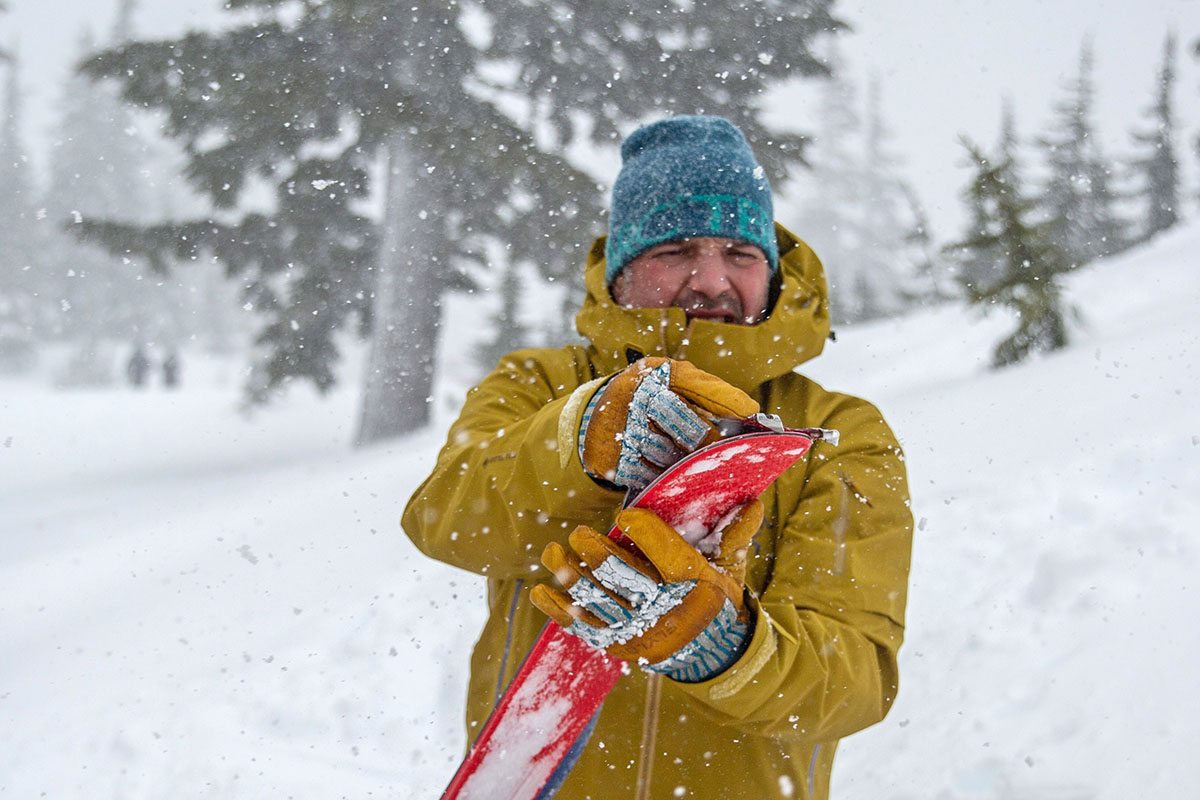
When it comes time to batten down the hatches, the Sabre comes well equipped. The large and adjustable StormHood is plenty big to fit over a wide range of ski helmets but cinches effectively and stays locked in place even in strong gusts or when bombing downhill. In addition, the collar is tall—fully zipped, it covers my lips completely—and the opening is wide enough to duck into when the weather turns particularly nasty (a plus for those who don’t like riding with a mask). It’s easy to seal out the cold and wet with a powder skirt and glove-friendly hem cinches at each side, and the wrists adjust easily and securely with Velcro. In addition, Arc’teryx uses a high-quality DWR coating (washing has helped keep it fresh) and water-resistant zippers that haven’t failed or leaked despite plenty of days in wet snow. A final piece of the waterproofing equation is the Sabre’s moderately long cut. Measuring 32 inches (81.5 cm) down the back for my men's size large, it hits a great balance of coverage without being overly bulky or inhibiting movement.
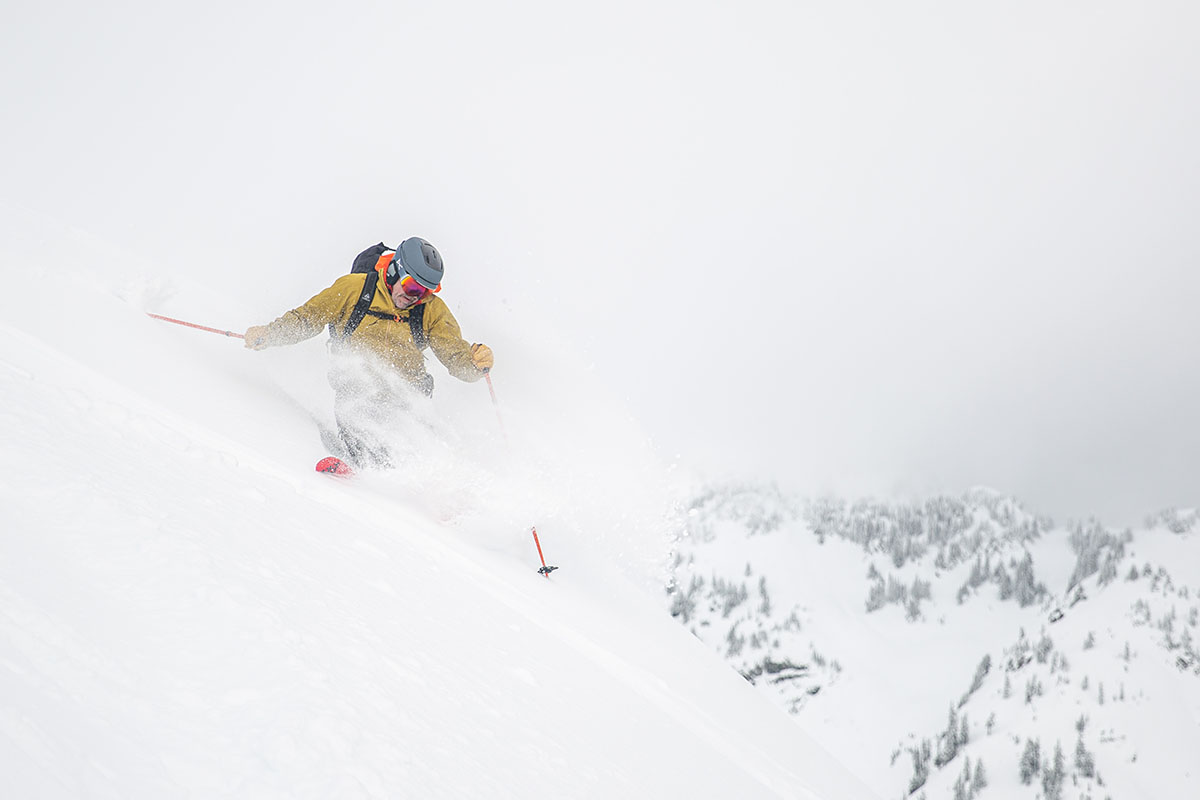
There are plenty of sturdy and weather-worthy ski shells on the market, but what makes the Sabre particularly impressive is how unnoticeable it is while you’re wearing it. Overall, the jacket offers excellent mobility with no restriction during transitions or when loading gear in and out of our van. In addition, Arc’teryx included a flannel backer along the interior, which helps limit the crinkly and stiff feel common among traditional 3-layer hardshells. It’s not up to softshell levels of flexibility and mobility, but it’s not too far off and has a fairly plush hand feel that isn’t prone to feeling cold and clammy (although not many will opt to wear short sleeves underneath). Finally, nice touches like small patches of fleece along the top of the collar and along the back of the neck enhance next-to-skin feel in the cold.
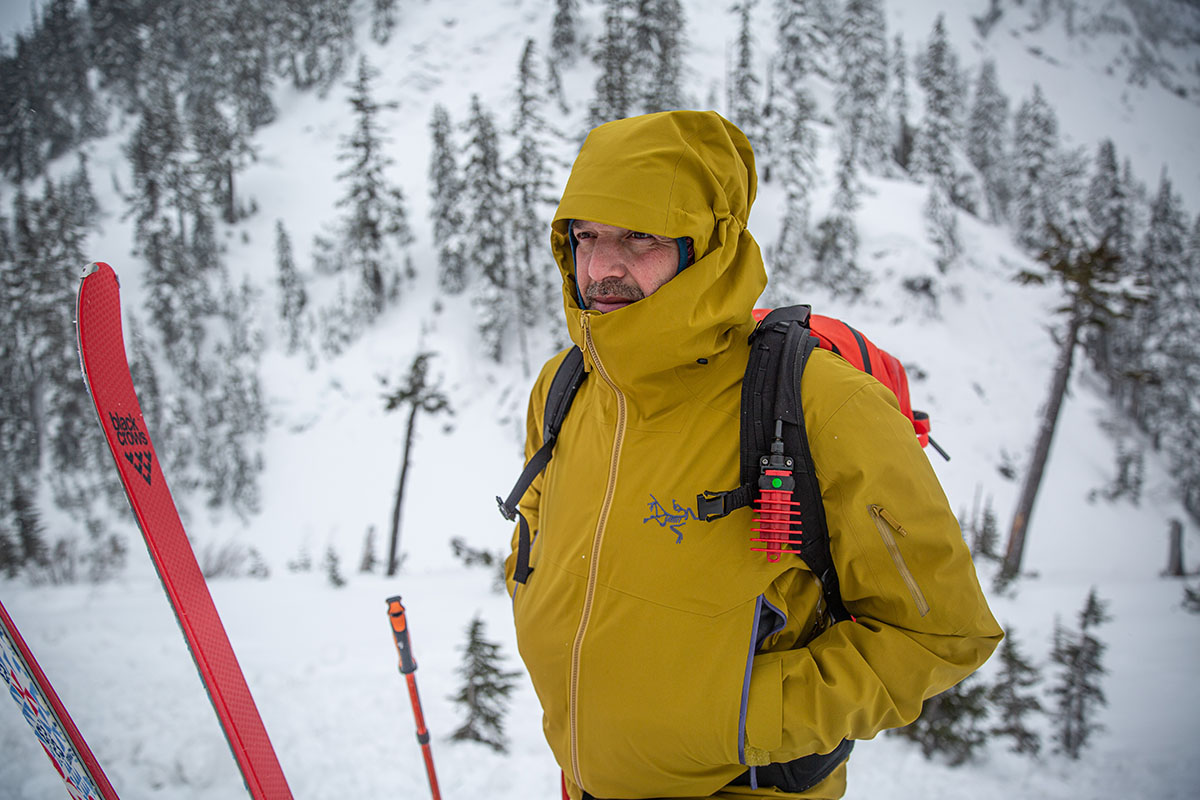
Right away, we’ll note that the Sabre is primarily intended as a resort/big mountain jacket, and its standard 3-layer Gore-Tex (as opposed to the more breathable Pro and Active membranes) and extra flannel backer prioritize protection and comfort over all-out ventilation. That said, I found it to be moderately breathable for short uphills while touring, and it was sufficient on steep sidecountry hikes of 30 minutes or less (and longer in colder temperatures). The large pit zips (around 14 in.) make it easy to dump heat, and as long as I wasn’t overdressed, the jacket did a decent job at keeping me from overheating. Dedicated backcountry skiers will be better off with a Gore-Tex Pro jacket like Arc’teryx’s own Rush or Alpha SV, but the Sabre is plenty capable for resort days and the occasional short tour (especially in frigid conditions).
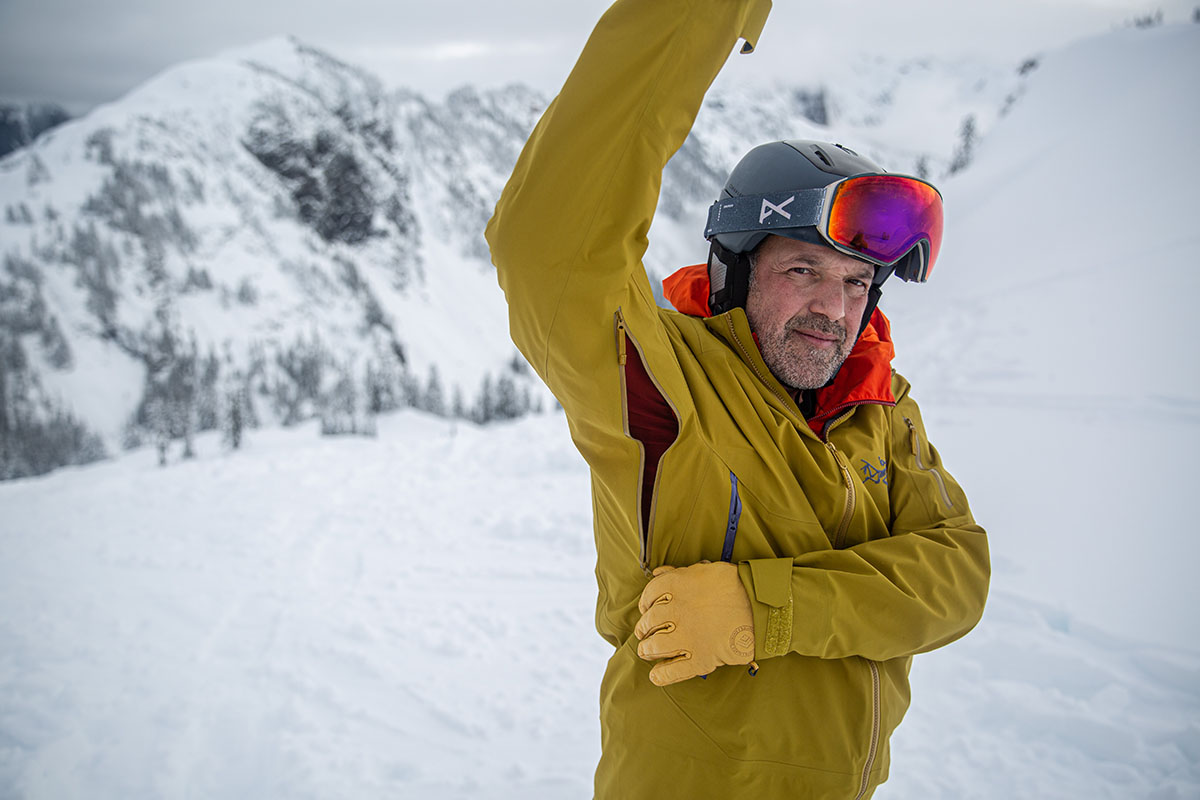
Just about all Arc’teryx products exude quality, and the Sabre Jacket is no exception. The face fabric has a clean look and has been flawlessly built, and the same goes for the seam taping along the interior (Arc’teryx even covered the taping with the brushed backer to enhance comfort). Additionally, every touch point is sturdy and has a quality feel: The zipper pulls are strong and reliable, the drawcord is robust and still functions like new, and the button-style adjustments along the side of the hood are easy to use.
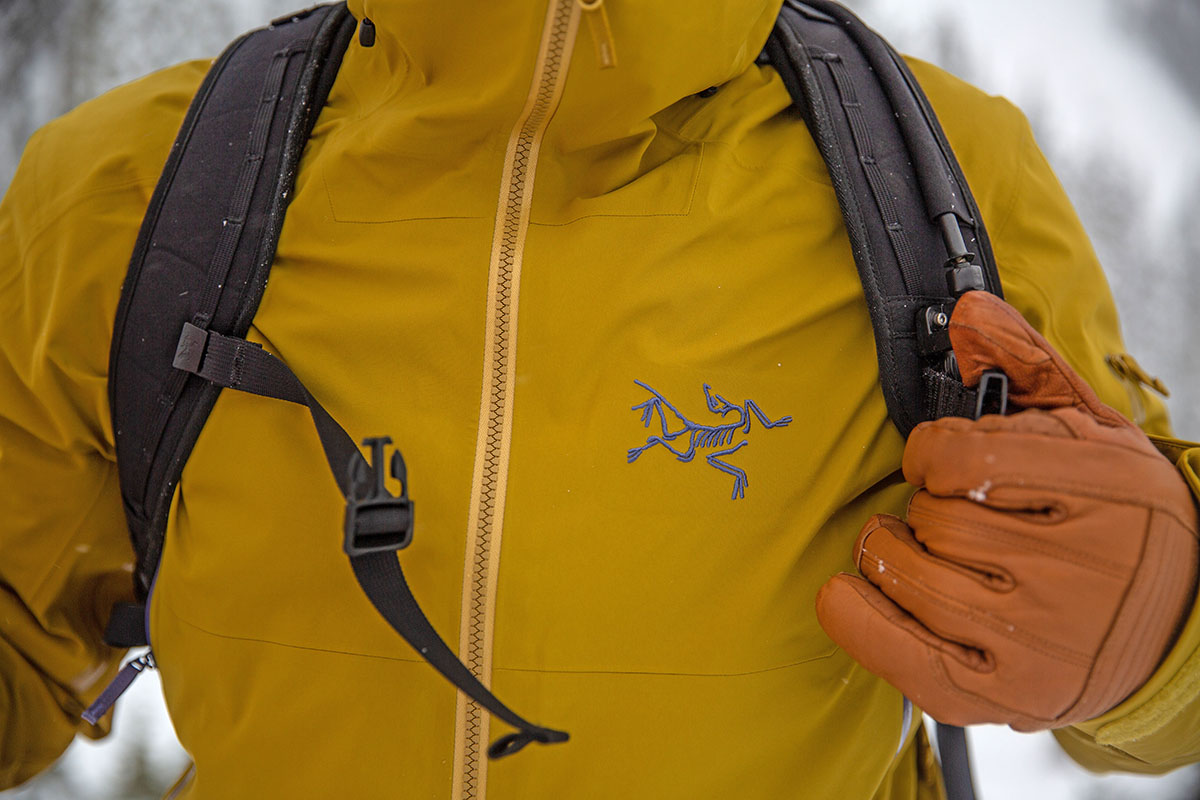
Importantly, the Arc'teryx Sabre Jacket has also proven to be quite durable. The face fabric is a premium 80-denier (D) material, which is fairly burly considering its lightweight feel. In addition, the thicker-than-average lining provides a boost in tear resistance. After getting over the concern of skiing through trees in such an expensive jacket, the durability proved to be fantastic. In fact, despite season-long abuse—including frequently stuffing the shell into my pack around other gear, throwing it haphazardly into our van, and even draping it over rocks for use as a seat during picnic lunches—the jacket is holding up fantastically. Based on my experiences with the prior-generation Sabre AR and newer model here, I expect it to have a very long lifespan with proper care and regular washes.

Listed at 1 pound 8.9 ounces, my Sabre Jacket in a size large weighed in a hair more at 1 pound 10 ounces. This puts it at about average among hardshells designed for mixed resort and backcountry use. In this category, Outdoor Research’s Hemispheres II weighs a very competitive 1 pound 3.7 ounces but omits a powder skirt and has a more streamlined fit, while Norrøna’s Lofoten Gore-Tex Pro checks in around the same weight (1 lb. 8.6 oz.). Those who spend more time in the backcountry will likely want to go even lighter with options like Arc’teryx’s own Rush (1 lb. 2.2 oz.) or Alpha SV (1 lb. 1.1 oz.). But as mentioned above, the extra weight is imperceptible on the slopes, and I certainly appreciate the added reliability and full feature set on resort days.
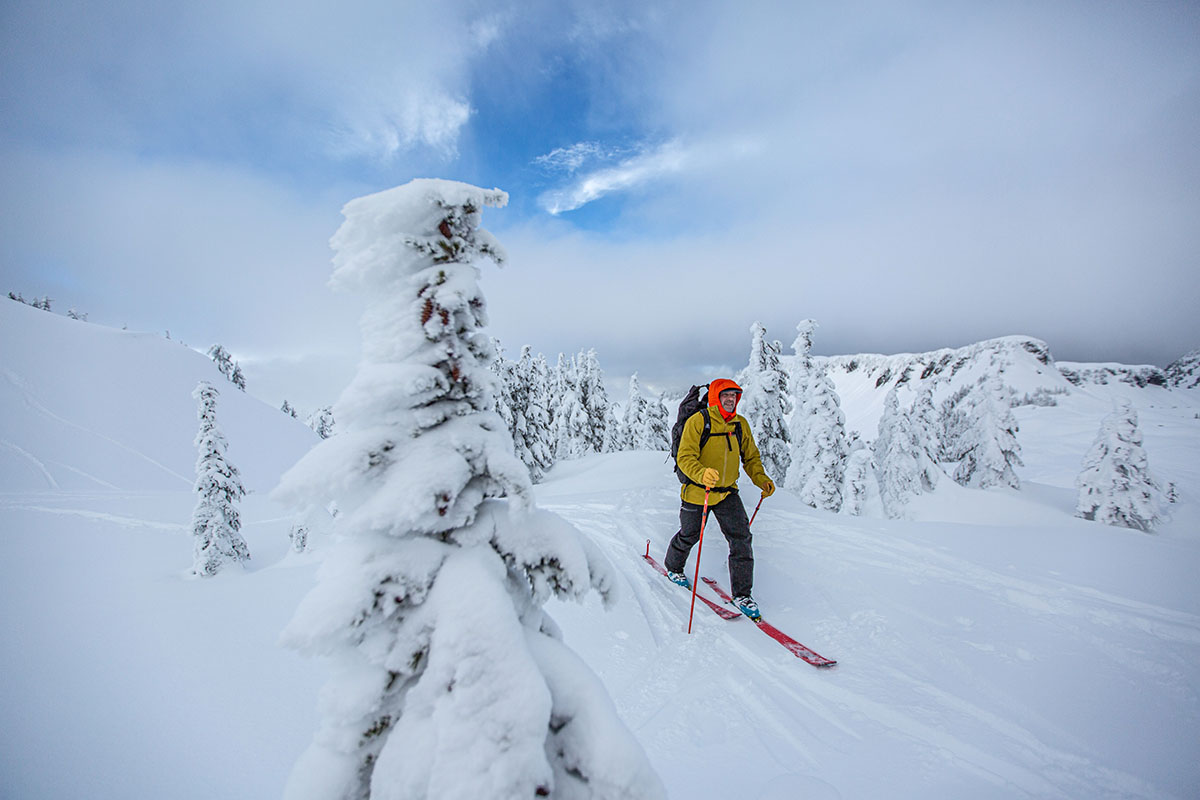
As far as packability goes, the Sabre Jacket’s substantial fabrics don’t stuff down all that small. Compressed into its own hood and with the drawcords cinched, it ends up being roughly the size of a large cantaloupe. When I’m in a hurry, however, I prefer to simply stuff the shell in my pack around other gear to fill the nooks and crannies. All in all, it certainly takes up a fair amount of space and won’t appeal to the fast-and-light crowd (I typically grab my Arc’teryx Rush Jacket for short, weight-conscious missions), but it’s perfectly suitable for shorter touring days when carrying a larger ski backpack.
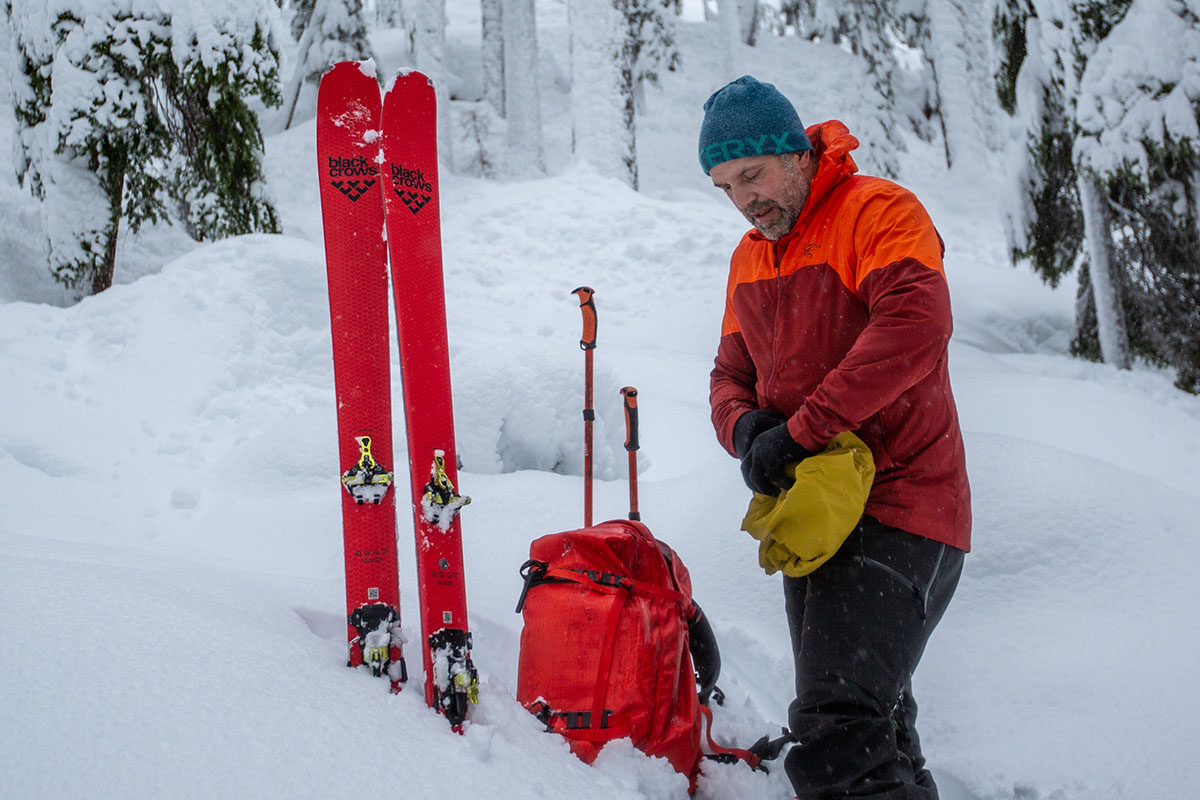
For the Sabre Jacket, Arc’teryx retained their well-loved StormHood design, which we’ve found to be among the most functional on the market. Overall, it hits a great balance of coverage and peripheral vision and stays locked in place even in very strong winds. For reference, when cinched fully, only my goggles and nose are exposed to the elements, which is great when the weather really takes a turn. Moreover, the stiff brim along the top effectively keeps moisture from falling onto the top of my helmet or ski goggles.
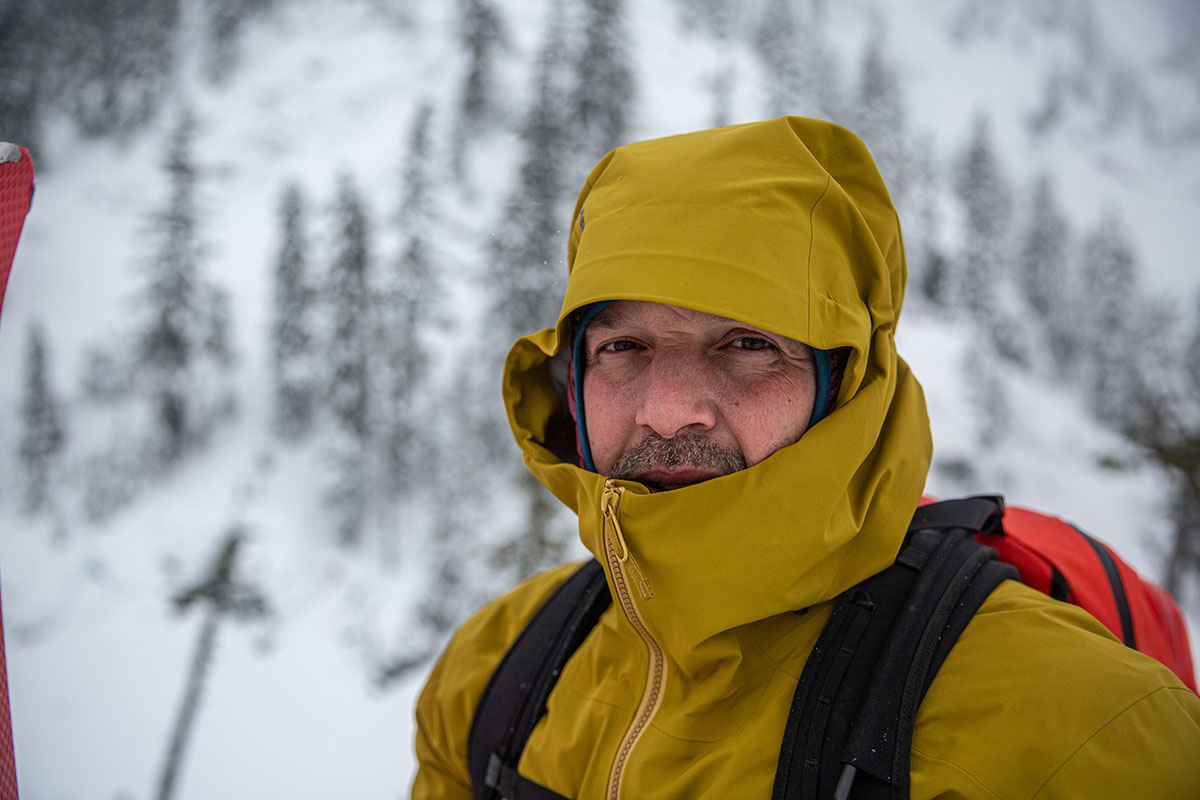
In terms of size and adjustability, the hood is very large and should fit just about any helmet underneath (my go-to lid during testing was Oakley’s Mod5), and it’s also adjustable enough to work with just a beanie or ball cap underneath. How it works: A large drawcord at the back adjusts around the sides and top of the forehead, while two cords secure the front. Regardless of your headwear choice, the hood cinches snugly and evenly without impacting side-to-side movement or peripheral vision. I’ve found it fairly easy to tweak the fit even with three-finger-style mitts on, although the buttons at the side of the hood can be a little finicky to pinch with bulky ski gloves (I often have to remove a glove when I’m in a hurry).
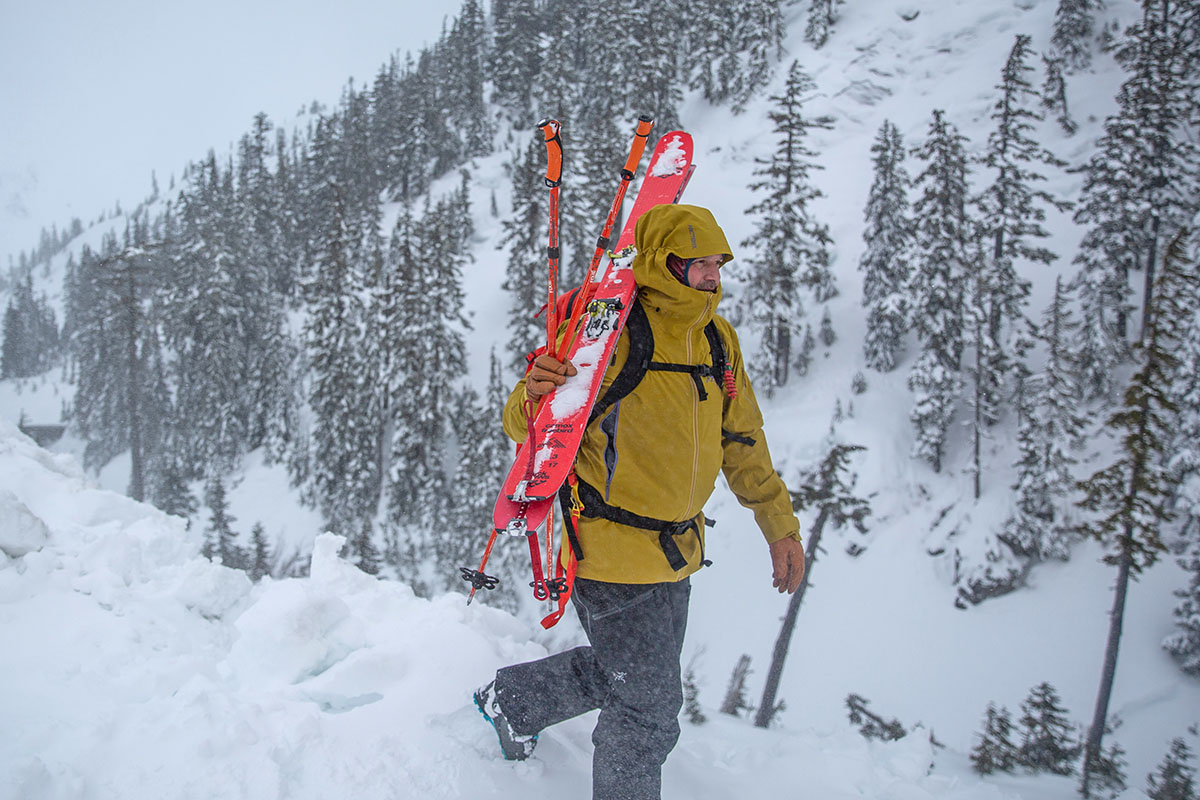
As far as storage is concerned, the Arc'teryx Sabre Jacket boasts six total pockets split evenly between the interior and exterior. Along the outside, there’s a sleeve pocket on the left arm that’s plenty large to accommodate a ski pass or small items like a credit card. Arc’teryx also cleverly stored a Recco reflector into the lining of this space, which makes it undetectable when wearing and doesn’t detract from the jacket’s clean look. Two large hand pockets flank the front of the jacket (bonus: They’re harness/hipbelt-friendly) and are protected by small zipper garages at the top to keep moisture from seeping through. We were a little surprised Arc’teryx didn’t use their RS Sliders here, which ditch the garages and self-seal, but it could’ve been an aesthetic choice or simply the fact that the jacket doesn’t prioritize shaving weight (these are more commonly found on the brand’s lightweight hardshells).
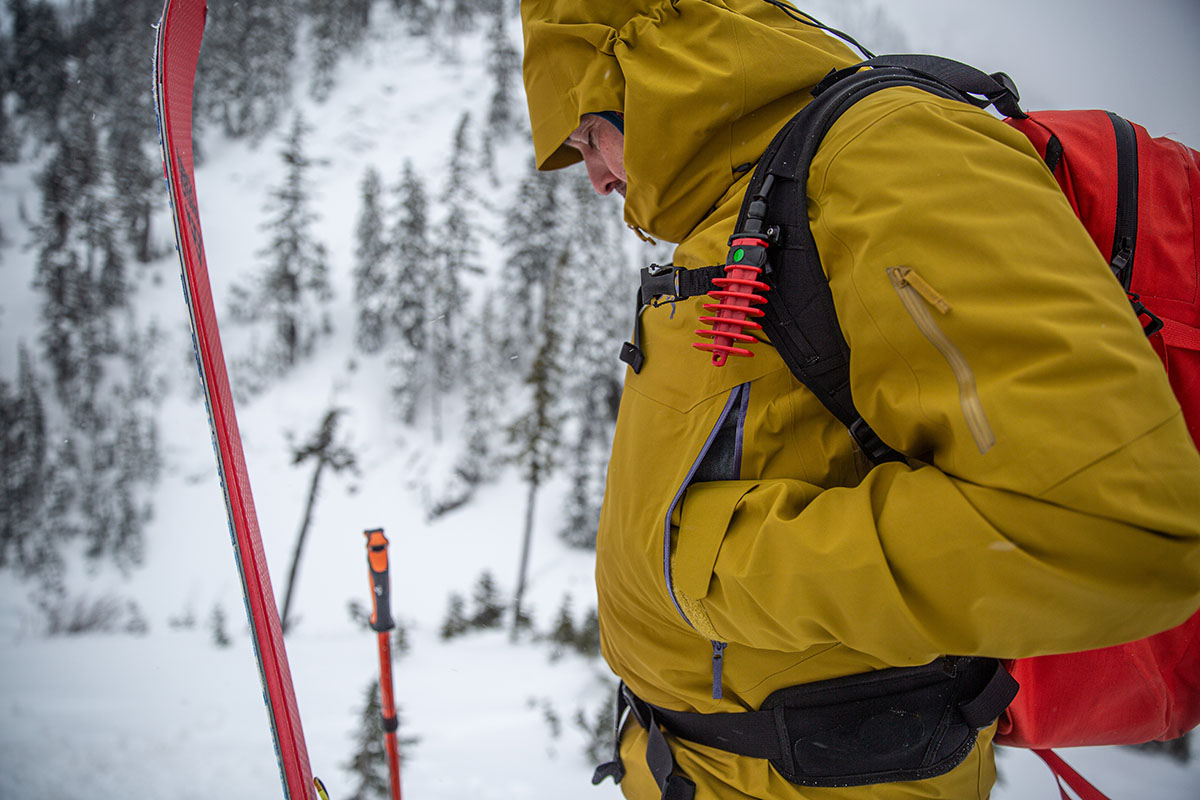
For the interior, you get two generously sized dump pockets (the prior-version AR model only had one) that were perfect for stashing goggles or climbing skins while doing yo-yo laps. They’re also made of a stretchy mesh material, which means they breathe well and readily allow moisture to escape. The left dump pocket also features a smaller zippered pocket at the front, which is nicely sized for smaller items like lip balm or keys. Given the stretch in the fabric, I was also able to get my phone inside, but it was a tight fit, and the lack of insulation means it can get cold and drain your battery (I used my midlayer for phone storage on exceptionally cold days).
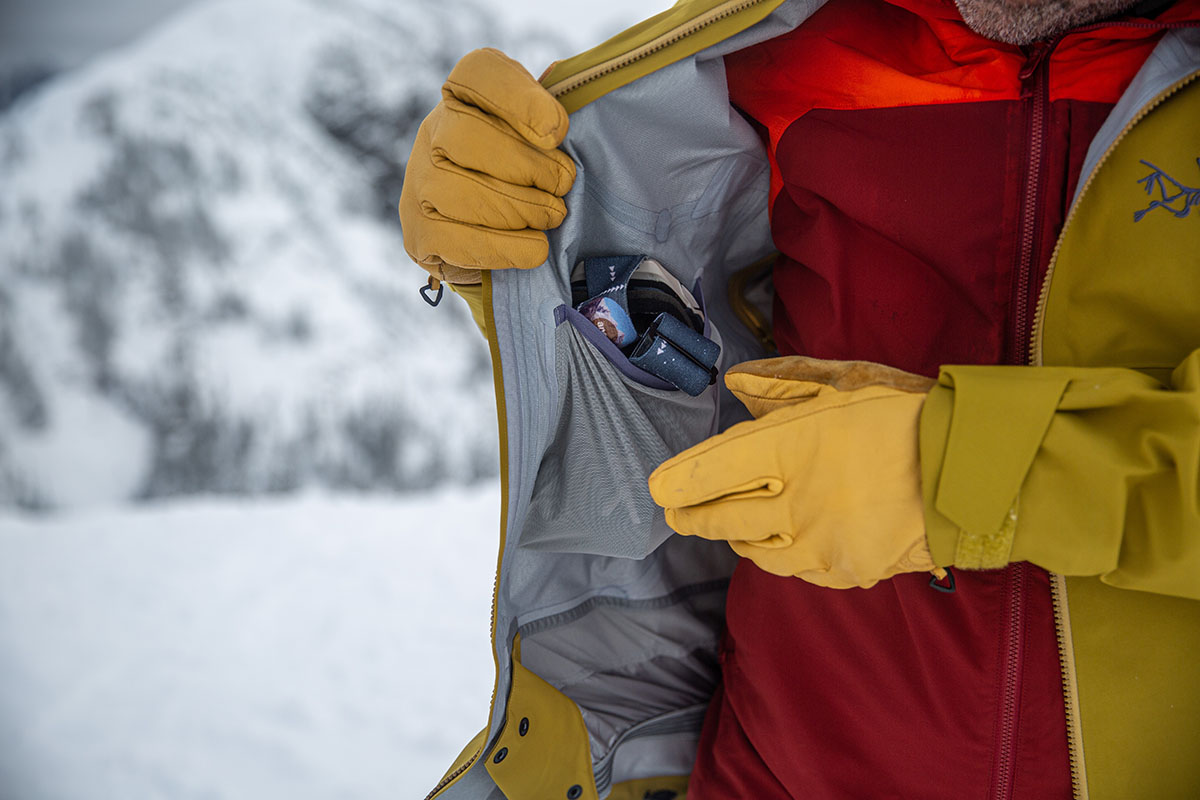
As with most dedicated ski shells, the Arc’teryx Sabre Jacket includes a powder skirt to seal out snow. The design secures along the front and includes two sets of buttons so you can tailor the snugness and overall fit. There’s a fair amount of stretch in the skirt, but I found it stays locked in place on the slopes—and even during falls—thanks to its silicone-like band. And for those who don’t like using a powder skirt or don’t want to utilize it on hardpack days, the low-profile design is practically unnoticeable and never bunched up or felt uncomfortable when unsecured.
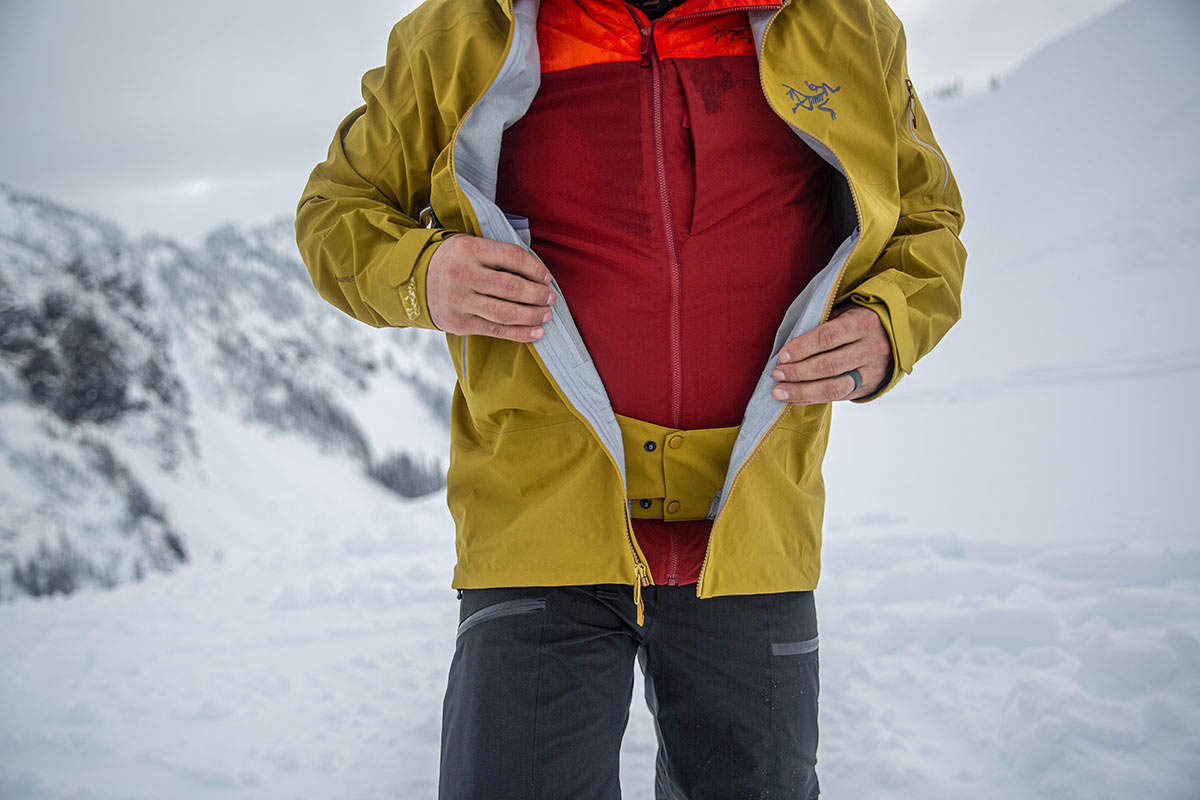
The powder skirt also features an attachment system that allows you to connect the jacket to compatible Arc’teryx bibs and pants (including the matching Sabre Pant, which I frequently pair with the shell). There are two connection points along the sides, and I’ve found them to be fairly easy to manipulate—doing so at the start of the day without gloves on is simplest—and secure enough that they’ve never come undone, even in a crash. The feature is far from necessary, but it’s a nice dose of added protection and gives the kit a one-piece, integrated feel.
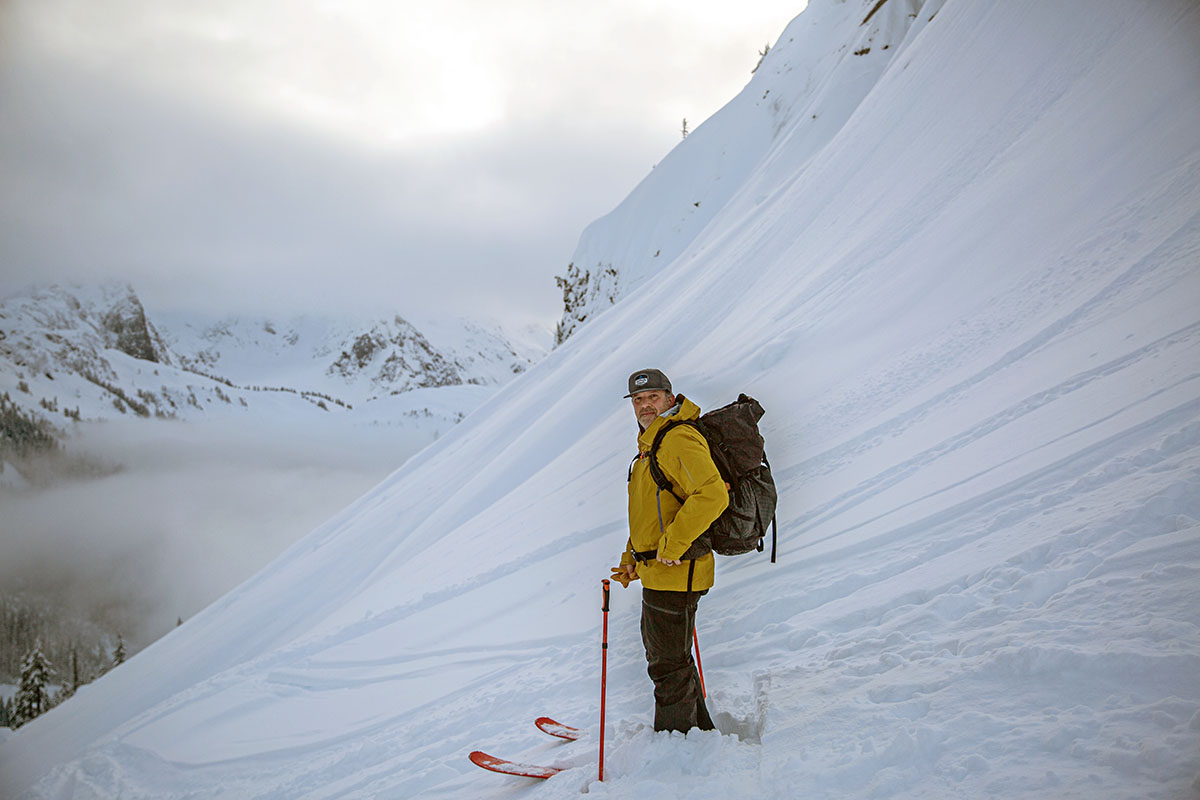
Like the past-generation Sabre AR, Arc’teryx’s latest Sabre Jacket boasts their “regular” fit, which is designed to be roomy enough for layering but not overly bulky. With that in mind, I opted for my usual size large and had no issues fitting my Arc’teryx Cerium Hoody underneath. That said, the Sabre that I tested fits slightly differently than the past-generation Sabre AR: It’s roomier overall but narrower in the waist and longer in the arms. This didn’t cause any comfort or mobility issues for me, but it’s definitely worth noting if you’re familiar with the fit of prior models. It also means the shell can feel a little large and unshapely without a layer underneath, but that shouldn’t be an issue for most skiers. I would prefer a more athletic cut for dedicated touring, but for lift-assisted days and sidecountry hikes, the Sabre is perfectly serviceable. A final gripe is that the Sabre lacks a two-way main zipper, which isn’t a dealbreaker but can be incredibly helpful for minimizing bunching when sitting or bending over.
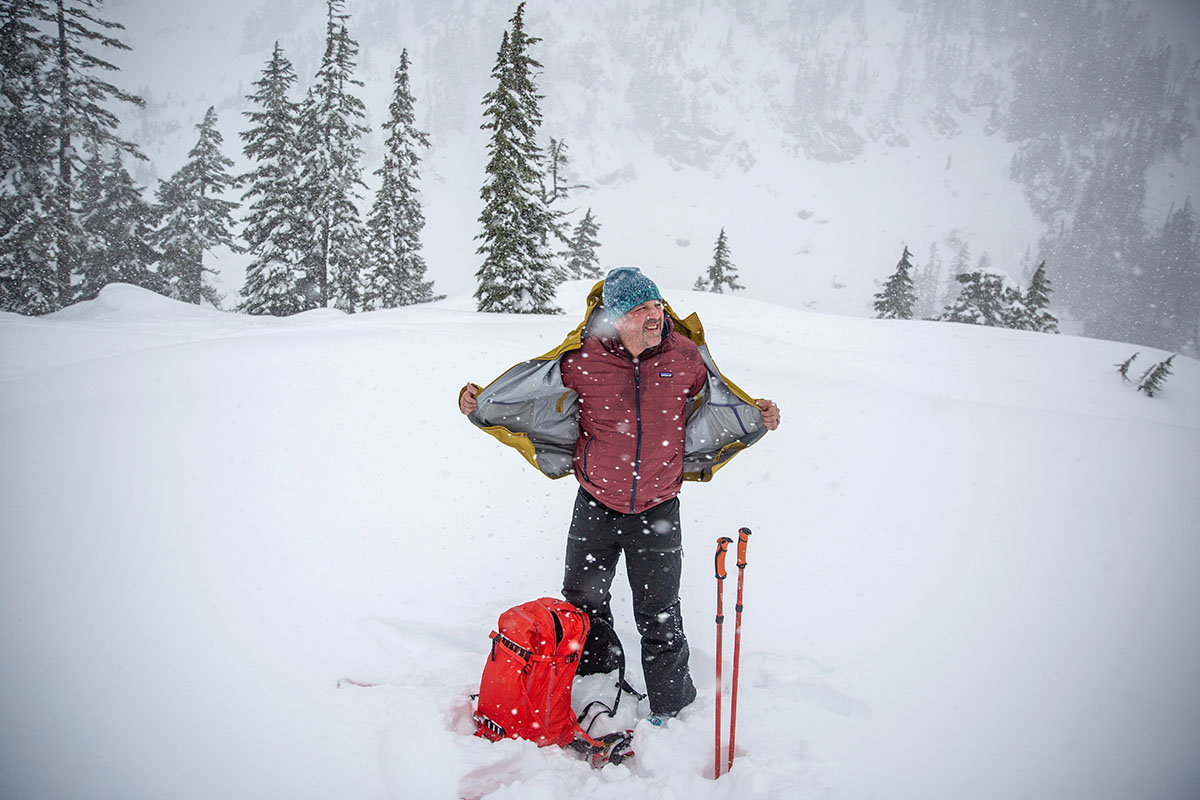
Sustainability is a bit of a buzzword in 2024, but we nevertheless appreciate when brands go the extra mile toward creating more eco-friendly products. The biggest news with the latest Sabre Jacket is the use of Gore’s ePE membrane, which is made from expanded polyethylene. Though still carbon-based like the ePTFE (expanded polytetrafluoroethylene) membrane featured in the jacket we tested for this review, Gore-Tex ePE is free from harmful per- and polyfluoroalkyl substances (PFAS for short), which are notorious for their inability to break down over time. The membrane is also both lighter and thinner, requiring fewer materials—thus, fewer pollutants—to produce. Tack on a recycled face fabric and bluesign-approved materials that meet strict chemical safety standards, and the net result is a very intentionally built piece that nicely reflects Arc’teryx’s ongoing sustainability efforts.
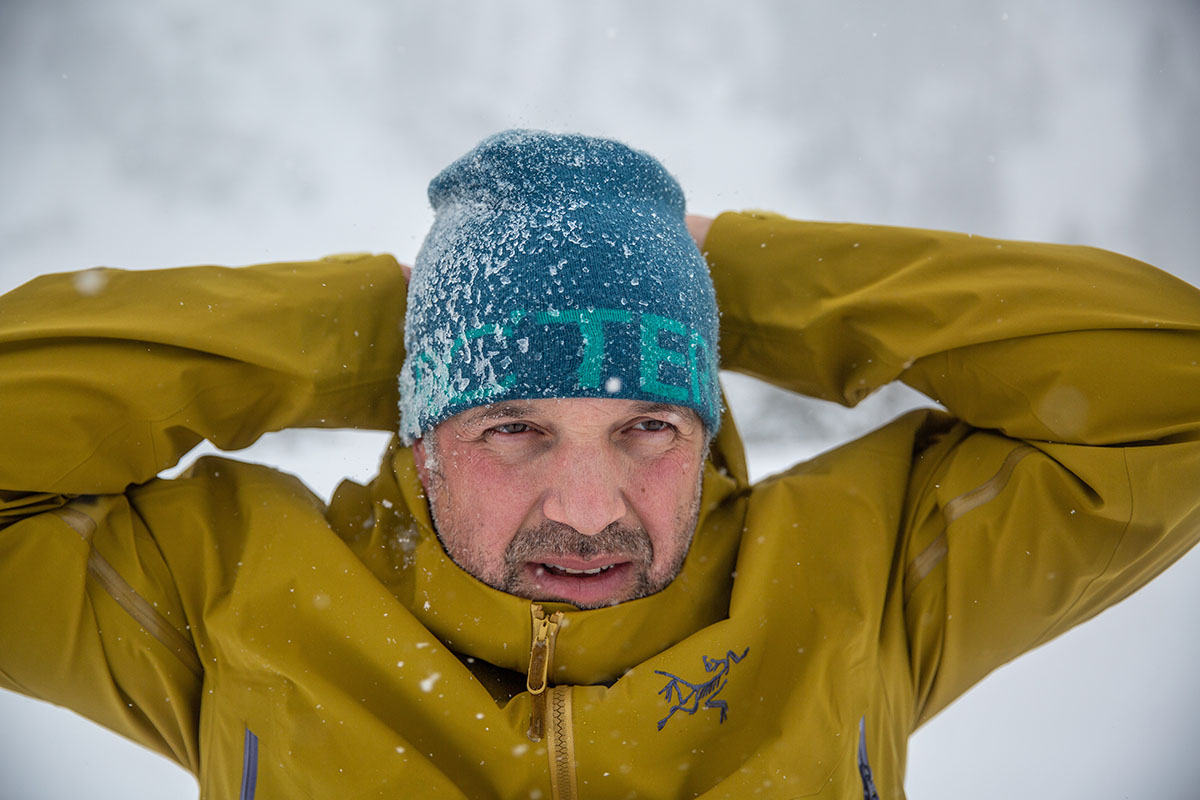
We put the flagship Sabre Jacket to the test for this review, and it’s sold in several other variations depending on your style and warmth preferences. At the top of the lineup is the Sabre SV (short for “severe weather”), which features extended coverage, a thicker (100D) face fabric, and an upgraded Gore-Tex Pro membrane. Next in line is the Sabre Insulated Jacket, which packs 80-gram Coreloft synthetic inside a 2-layer Gore-Tex shell. Finally, the Sabre Relaxed Anorak features a roomy freeride aesthetic with a half-length front zipper and extra-beefy (200D) construction. To complete your kit, Arc’teryx sells the matching Sabre Pant, Sabre Relaxed Pant, and Sabre Bib Pant, all of which use Gore’s latest ePE membrane.
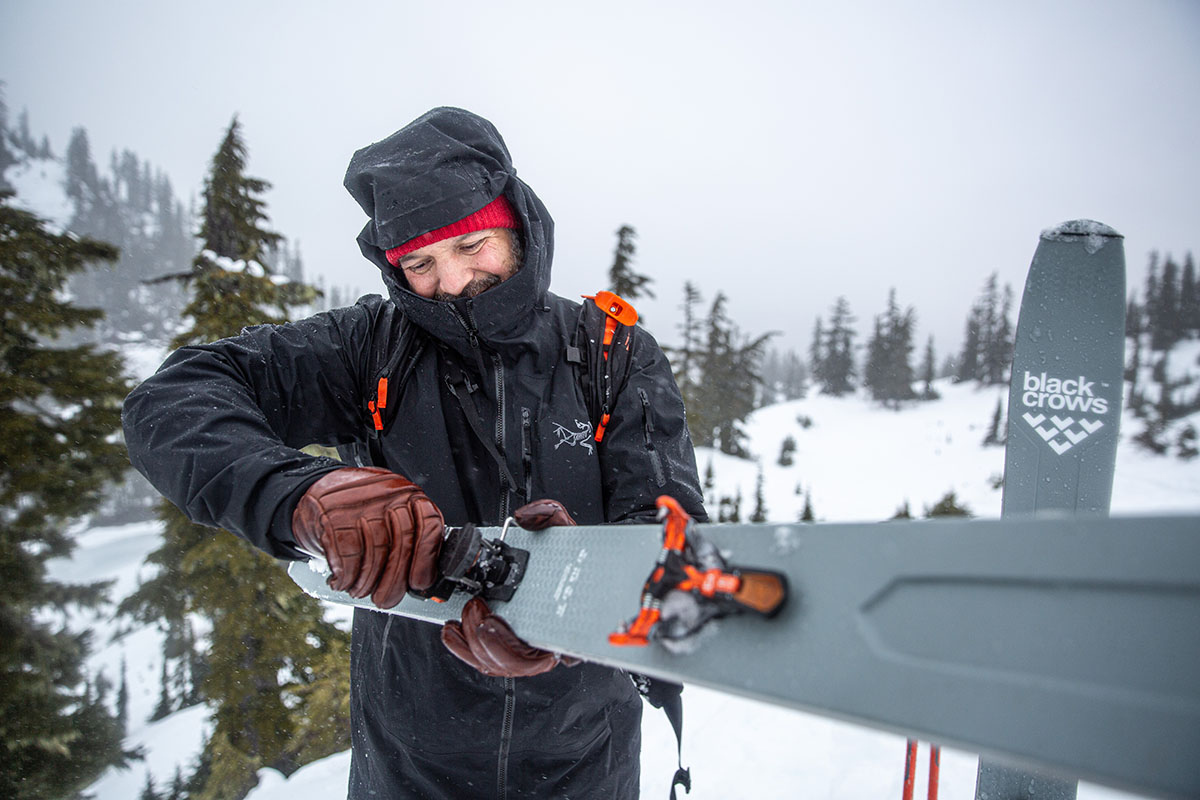
On the women’s side, the Sentinel Jacket (formerly the Sentinel AR) costs the same as the Sabre and has a nearly identical construction and feature set but comes in different colorways and weighs less at 1 pound 5.3 ounces. For those who prefer a roomier fit, it’s also sold in a “relaxed” variation that’s largely similar. And if you’re looking for a step up in warmth for cold resort days, Arc’teryx offers two insulated models: the Sentinel Insulated Jacket and Sentinel Insulated Anorak, with the former using slightly thicker synthetic fill. Rounding out the collection are four pant options: the standard Sentinel Pant, Sentinel Insulated Pant, Sentinel Relaxed Pant, and full-coverage Sentinel Bib Pant.
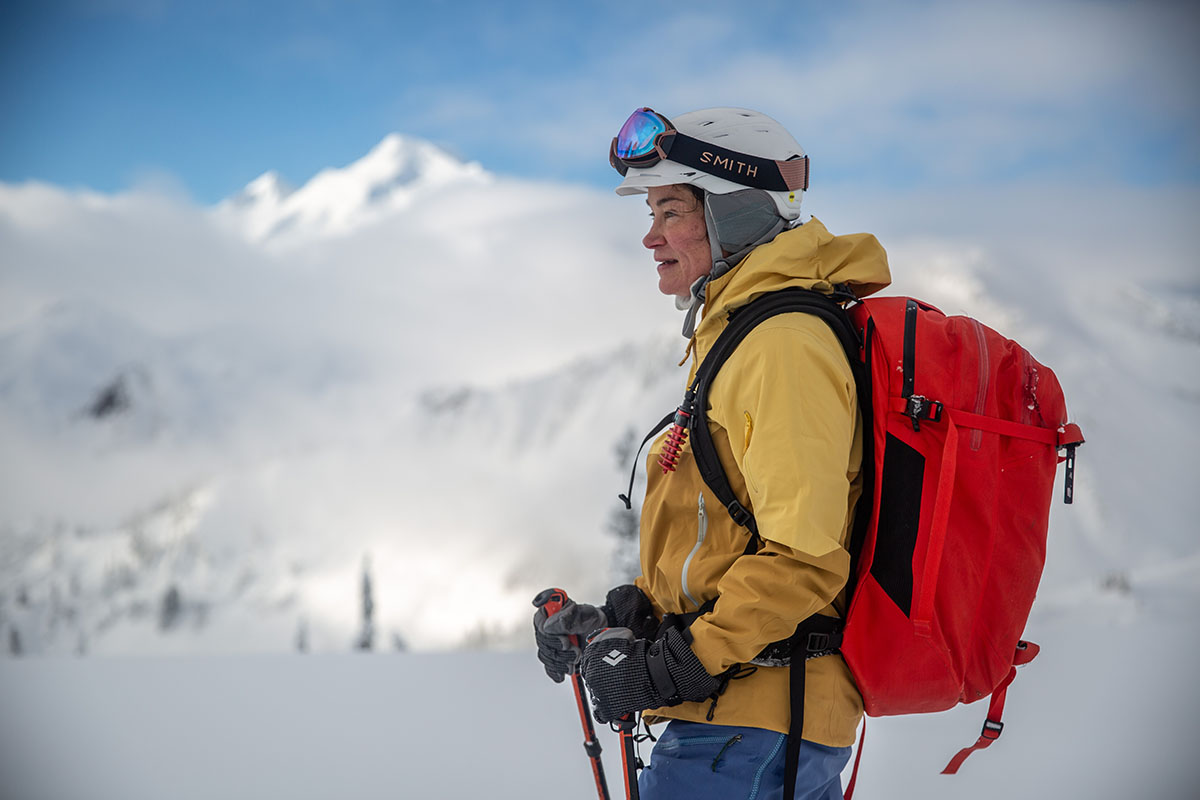
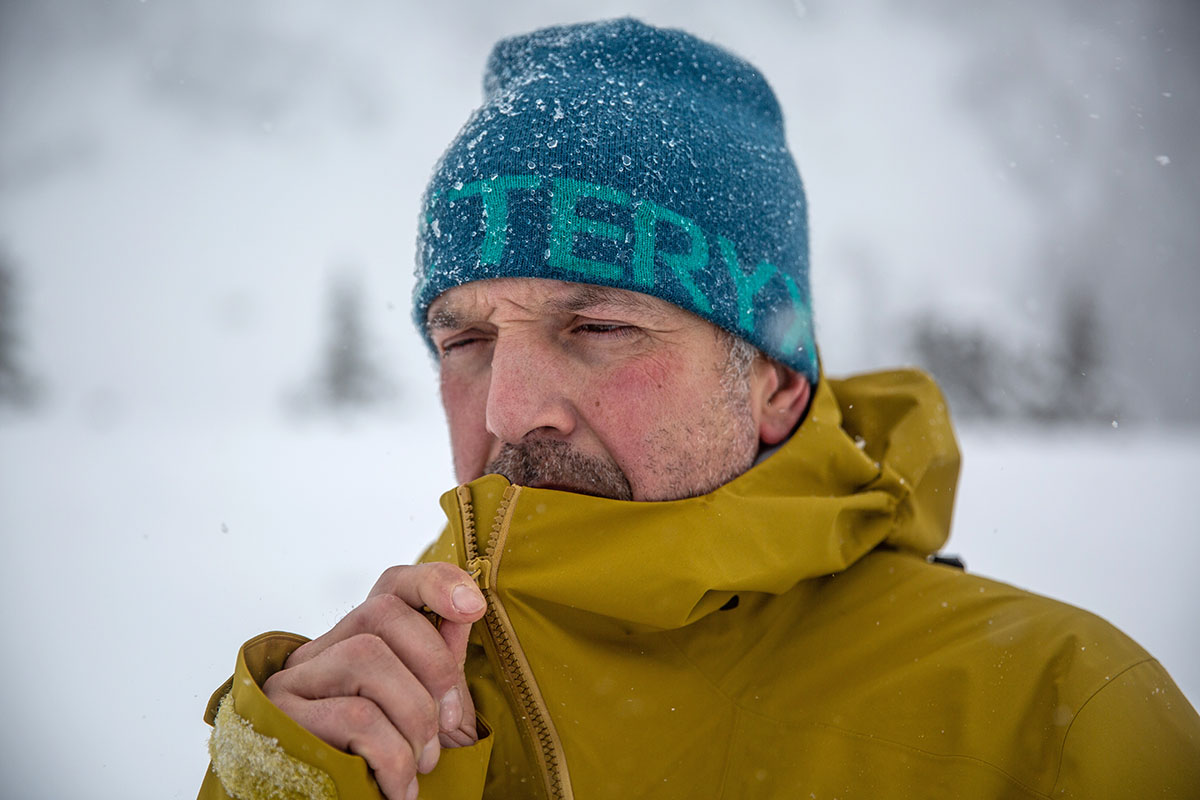
| Jacket | Price | Best For | Insulated | Waterproof | Weight | Recco |
|---|---|---|---|---|---|---|
| Arc'teryx Sabre Jacket | $750 | Resort/backcountry | No (flannel backer) | 3L Gore-Tex ePE | 1 lb. 8.9 oz. | Yes |
| Norrøna Lofoten | $799 | Backcountry/resort | No | 3L Gore-Tex Pro | 1 lb. 8.6 oz. | No |
| OR Hemispheres II | $649 | Backcountry/resort | No | 2L & 3L Gore-Tex | 1 lb. 3.7 oz. | No |
| OR Skytour AscentShell | $429 | Backcountry | No | 3L AscentShell | 1 lb. 5.0 oz. | No |
| Trew Cosmic Primo | $499 | Resort/backcountry | No | 3L PNW Primo | 1 lb. 14.1 oz. | Yes |
| Arc'teryx Rush | $700 | Backcountry | No | 3L Gore-Tex Pro | 1 lb. 2.2 oz. | Yes |
Arc’teryx’s Sabre Jacket is one of our favorite ski jackets this year for its premium build quality and all-around performance. Another technical mountain specialist to have on your radar is Norway-based Norrøna, and their competitor to the Sabre is the Lofoten Gore-Tex Pro Jacket. Unlike the Sabre, the Lofoten uses Gore’s top-of-the-line Pro membrane, which makes it the better true backcountry companion. We also love the mesh-backed zipper along the front, which provides another way to dump heat in addition to the generous pit zips. The Sabre is the more well-rounded option with better everyday comfort and a more functional storage layout for resort use (the Lofoten omits hand pockets), but the Norrøna is the superior touring design with stalwart protection for truly serious alpine conditions.
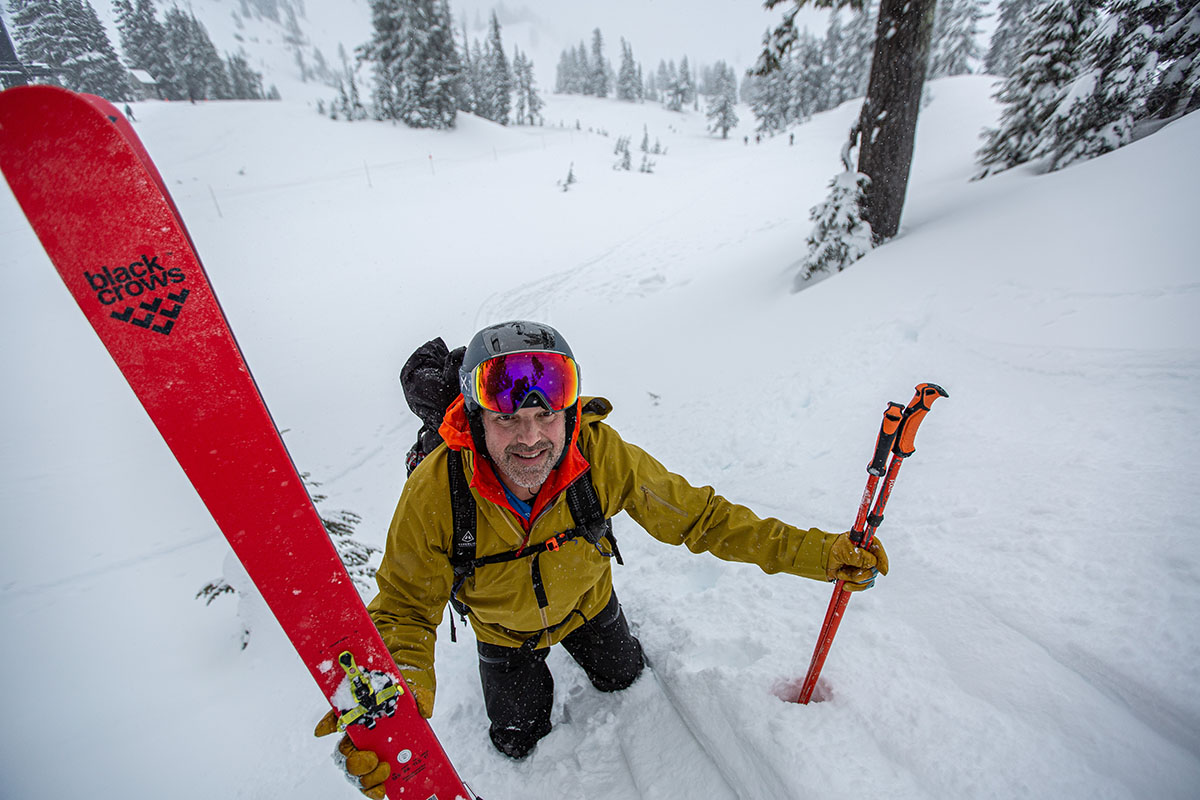
Like the Sabre, Outdoor Research’s Hemispheres II Jacket is a nice option for both in- and out-of-bounds skiing. The most notable feature on the Hemispheres is the use of 2-layer Gore-Tex with Stretch panels at the back, hood, and cuffs. This gives the jacket a major bump in mobility without sacrificing overall weather protection (the rest of the jacket uses the same 3-layer Gore-Tex as the Sabre). The Hemispheres also uses Gore’s soft C-Knit backer along the interior, which is a step down in warmth from the Sabre’s flannel liner but provides a nice dose of comfort. Further, the OR has larger pit zips that extend from the hem to the armpit, is lighter at 1 pound 3.7 ounces, and has a couple more pockets. That said, the OR forgoes a powder skirt, fits a little narrow in the shoulders and waist, and has a smaller hood that doesn’t slide as easily over a bulky ski helmet. Given these gripes, we give the slight nod to the Sabre.
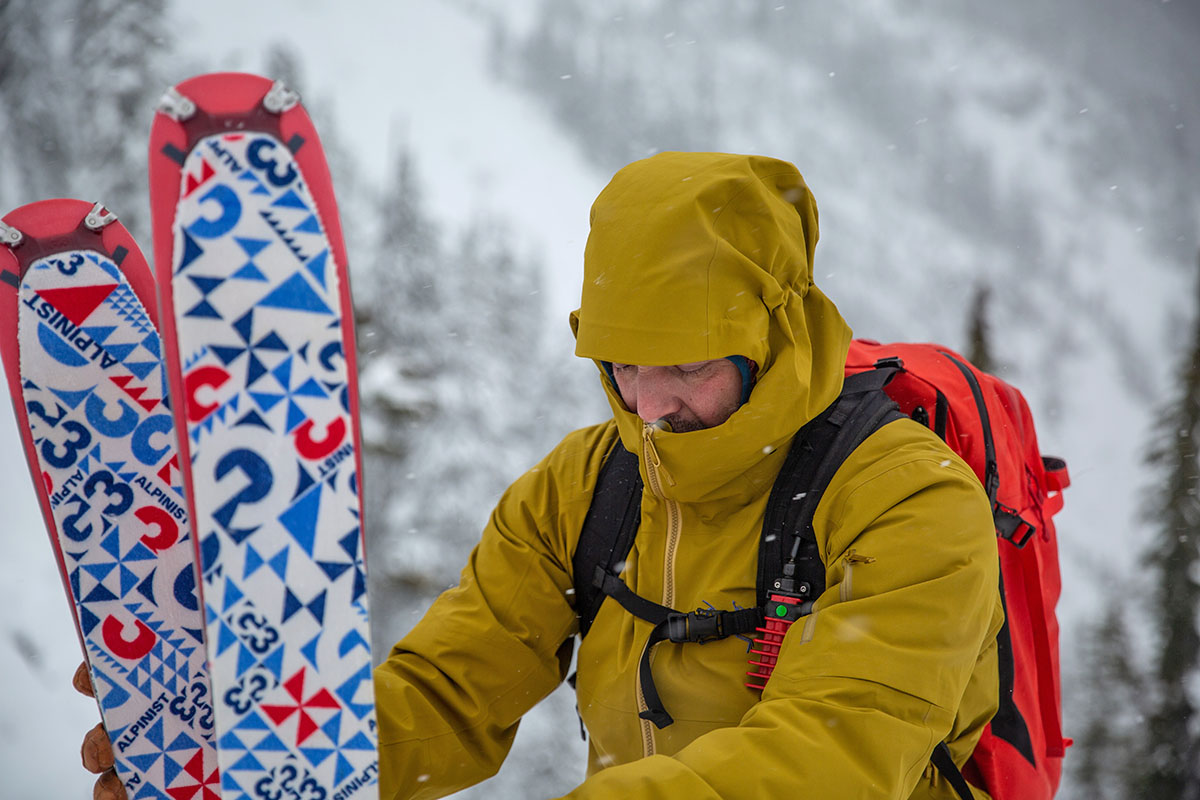
For dedicated backcountry skiers, there are several lighter and more breathable options available, including another standout from OR: their Skytour AscentShell Jacket. As its name suggests, the Skytour trades Gore-Tex for OR’s in-house AscentShell membrane (also 3-layer), which we’ve found offers softshell-like mobility, comfort, and breathability while still providing solid wet-weather protection. The Skytour also features more storage with six total pockets and weighs less at 1 pound 5 ounces. However, the OR’s thinner build (40 x 65D) is no match for the Sabre’s thick 80D construction for rough and frequent inbounds use, and build quality is a step down from Arc’teryx’s painstaking attention to detail—for example, the single hem toggle pulls the jacket to the side when cinched, and the AscentShell fabric is less trustworthy than Gore-Tex in heavy and sustained moisture. In the end, the Skytour is a very solid value at $429, but dedicated resort-goers who are hard on their gear won't regret stepping up to the Sabre.
Next up is Trew Gear’s Cosmic Primo, which targets the crossover resort and touring space with a tough 3-layer construction, a whopping eight total pockets (two more than the Sabre), and a long cut that offers excellent coverage. In comparing the two shells, the Sabre gets the edge in all-out protection thanks to its Gore-Tex membrane (the Cosmic uses Trew’s in-house PNW tech) and checks in 5.2 ounces lighter. On the flip side, the Trew Gear will save you around $250 while offering a boost in organization, along with better mobility thanks to the addition of mechanical stretch in the fabric. Given its lower weight and more streamlined build, we consider the Sabre to be the better all-rounder for mixed resort and backcountry use, but the Cosmic is an excellent resort piece that will get the job done on the occasional tour (for more info, check out our in-depth Cosmic Primo review).
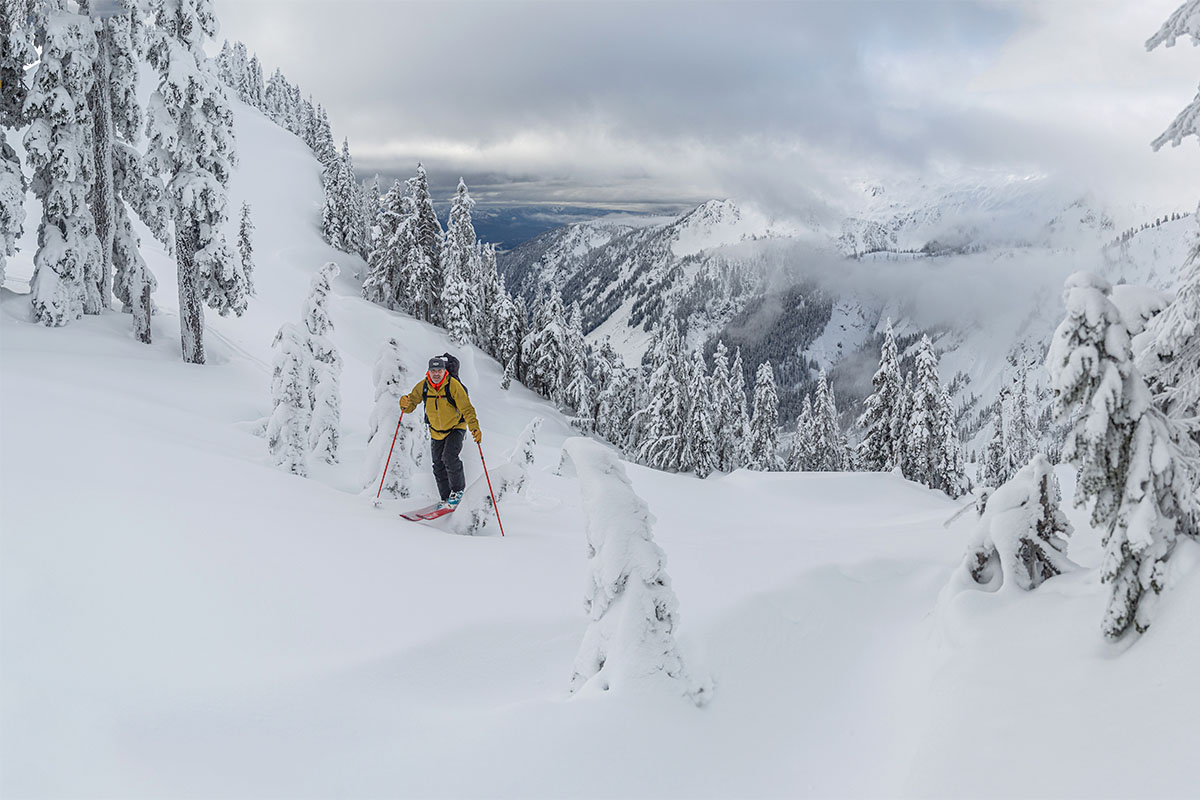
Last but not least is Arc’teryx’s own Rush Jacket, which costs $50 less than the Sabre and comes with a couple worthwhile upgrades for backcountry enthusiasts. First is protection: The Rush boasts Gore’s top-end Pro membrane and tacks on their Most Rugged Technology for a boost in tear resistance (both shells are 80D). Despite the advantages in waterproofing and durability, the Rush also checks in around 7 ounces lighter than the Sabre and has a slightly longer cut to boot (center back length in a men’s large is 32.3 in./82 cm). However, it leaves out the Sabre’s thin flannel backer, which we love for overall comfort and warmth on cold resort days. In the end, we’d break it down as follows: The Sabre is the better pick for skiers who spend most of their time inbounds (especially in colder climates), while the Rush is the more versatile choice for mixed front- and backcountry use.
If you’re thinking about buying gear that we’ve reviewed on Switchback Travel, you can help support us in the process. Just click on any of the seller links above, and if you make a purchase, we receive a small percentage of the transaction. The cost of the product is the same to you but this helps us continue to test and write about outdoor gear. Thanks and we appreciate your support!
Depending on the seller, most products ship free in the United States on orders of $50 or more. International shipping availability and rates vary by seller. The pricing information on this page is updated hourly but we are not responsible for inaccuracies.